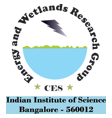Indian Institute of Science, Bangalore 560 012
Tel: 080-22932043 / 3251 / 3099
(E-mail:
cestvr@cistup.iisc.ernet.in)
Co-ordinators: |
T.V. Ramachandra (cestvr@cistup.iisc.ernet.in), Rajasekara Murthy(dakshamurthy@hotmail.com) |
Venue: |
CiSTUP Conference Room (SID Building), IISc campus
(location details are available at
http://cistup.iisc.ernet.in) |
Schedule: |
27th - 28thFebruary 2015,
9 am to 6.00 pm |
Urbanization is a phenomenon in the later part 19th and early 20th centuries in the developed world. In the developing world it is still continuing with rapid urban growth commencing in the later part of 20th century and is unlikely to finish in the foreseeable future. Urbanization is a planetary phenomena and rapid urbanization is a distinctive feature in Asia and India is no exception. By 2015, 153 cities over a million inhabitants and 15 megacities over ten million inhabitants, will be in Asia. This accounts for about 50% of the world urban population. (Indian Tier I and II Cities). Cities are dynamic systems with complex interactions between socio-economic and environmental processes at the local, regional and Global scales. As per World Bank estimates in the developing countries, as much as 80 % economic growth will occur in cities. Thus cities are also the focal point of a diversity of ecological and environmental problems with severe local, regional and global negative consequences that potentially affect millions of inhabitants. Despite their importance for economic growth, cities have not received the level of importance for mitigating the negative impact of ecological and environmental changes and this is particularly evident in India.
Bangalore is one of the fastest growing cities in Asia with a population of well over 8 million and growing rapidly in all directions. Bangalore is experiencing unprecedented urbanisation and sprawl in recent times due to concentrated developmental activities with impetus on industrialisation for the economic development of the region. This concentrated growth has resulted in the increase in population and consequent pressure on infrastructure, natural resources and ultimately giving rise to a plethora of serious challenges such as climate change, enhanced green-house gases emissions, lack of appropriate infrastructure, traffic congestion, and lack of basic amenities (electricity, water, and sanitation) in many localities, etc. This study shows that there has been a growth of 632% in urban areas of Greater Bangalore across 38 years (1973 to 2010). Urban heat island phenomenon is evident from large number of localities with higher local temperatures. The study unravels the pattern of growth in Greater Bangalore and its implication on local climate (an increase of ~2 to 2.5 ºC during the last decade) and also on the natural resources (76% decline in vegetation cover and 79% decline in water bodies), necessitating appropriate strategies for the sustainable management of natural resources.
With accelerated economic development and coupled with uncontrolled urbanization, the city is now experiencing severe environmental problems of air, land, water and urban ecosystem. The number of vehicles has increased exponentially over the last ten years and estimated to be around 5 million, contributes 60-70- per cent of the pollution load to the Bangalore environment. Similarly unplanned solid waste and municipal waste-water management has contributed to unacceptable public health and sanitation concerns. To address and identify the ecological and environmental impacts of rapid economic development and unchecked urbanization in Bangalore, this workshop will be organized at Conference Room (CiSTUP & SID), Ground Floor, CiSTUP, IISc., during 27 -28 Feb 2015.

